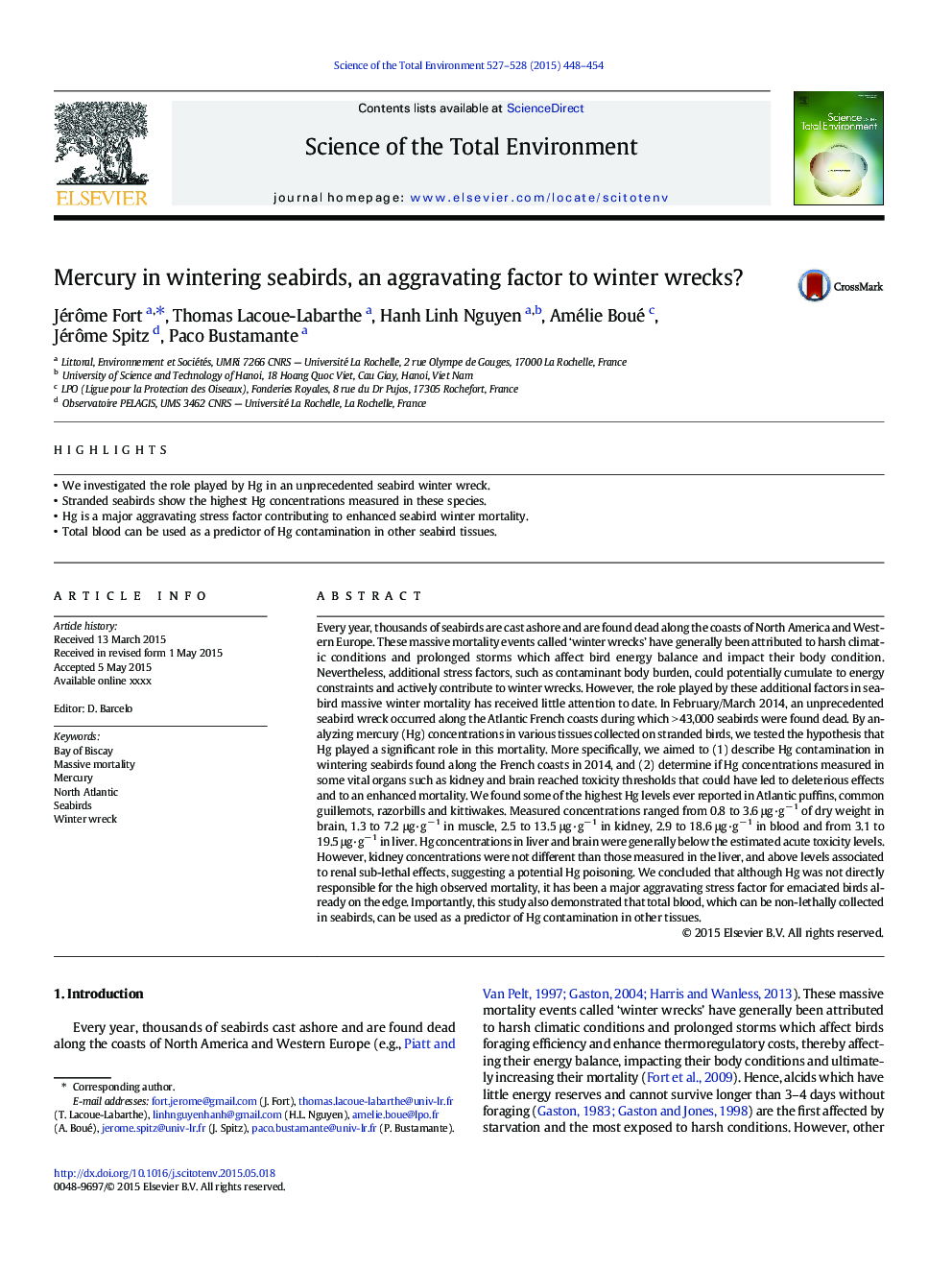| کد مقاله | کد نشریه | سال انتشار | مقاله انگلیسی | نسخه تمام متن |
|---|---|---|---|---|
| 6326520 | 1619755 | 2015 | 7 صفحه PDF | دانلود رایگان |
عنوان انگلیسی مقاله ISI
Mercury in wintering seabirds, an aggravating factor to winter wrecks?
ترجمه فارسی عنوان
جیوه در پرنده های زمستانی، یک عامل تشدید کننده در زمستان خراب؟
دانلود مقاله + سفارش ترجمه
دانلود مقاله ISI انگلیسی
رایگان برای ایرانیان
کلمات کلیدی
خلیج بیسکی، مرگ و میر عظیم، جیوه، آتلانتیک شمالی، پرنده ها، خرابی زمستانی،
موضوعات مرتبط
علوم زیستی و بیوفناوری
علوم محیط زیست
شیمی زیست محیطی
چکیده انگلیسی
Every year, thousands of seabirds are cast ashore and are found dead along the coasts of North America and Western Europe. These massive mortality events called 'winter wrecks' have generally been attributed to harsh climatic conditions and prolonged storms which affect bird energy balance and impact their body condition. Nevertheless, additional stress factors, such as contaminant body burden, could potentially cumulate to energy constraints and actively contribute to winter wrecks. However, the role played by these additional factors in seabird massive winter mortality has received little attention to date. In February/March 2014, an unprecedented seabird wreck occurred along the Atlantic French coasts during which > 43,000 seabirds were found dead. By analyzing mercury (Hg) concentrations in various tissues collected on stranded birds, we tested the hypothesis that Hg played a significant role in this mortality. More specifically, we aimed to (1) describe Hg contamination in wintering seabirds found along the French coasts in 2014, and (2) determine if Hg concentrations measured in some vital organs such as kidney and brain reached toxicity thresholds that could have led to deleterious effects and to an enhanced mortality. We found some of the highest Hg levels ever reported in Atlantic puffins, common guillemots, razorbills and kittiwakes. Measured concentrations ranged from 0.8 to 3.6 μg·gâ 1 of dry weight in brain, 1.3 to 7.2 μg·gâ 1 in muscle, 2.5 to 13.5 μg·gâ 1 in kidney, 2.9 to 18.6 μg·gâ 1 in blood and from 3.1 to 19.5 μg·gâ 1 in liver. Hg concentrations in liver and brain were generally below the estimated acute toxicity levels. However, kidney concentrations were not different than those measured in the liver, and above levels associated to renal sub-lethal effects, suggesting a potential Hg poisoning. We concluded that although Hg was not directly responsible for the high observed mortality, it has been a major aggravating stress factor for emaciated birds already on the edge. Importantly, this study also demonstrated that total blood, which can be non-lethally collected in seabirds, can be used as a predictor of Hg contamination in other tissues.
ناشر
Database: Elsevier - ScienceDirect (ساینس دایرکت)
Journal: Science of The Total Environment - Volumes 527â528, 15 September 2015, Pages 448-454
Journal: Science of The Total Environment - Volumes 527â528, 15 September 2015, Pages 448-454
نویسندگان
Jérôme Fort, Thomas Lacoue-Labarthe, Hanh Linh Nguyen, Amélie Boué, Jérôme Spitz, Paco Bustamante,
